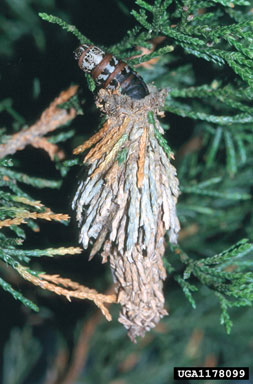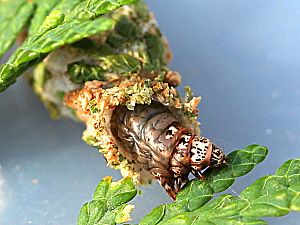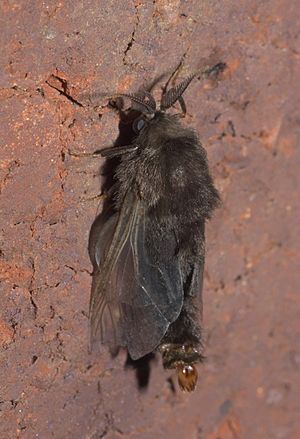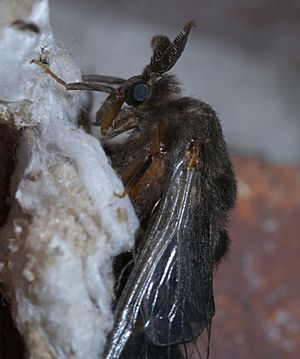Evergreen bagworm facts for kids
Quick facts for kids Evergreen bagworm |
|
|---|---|
 |
|
| Scientific classification |
The evergreen bagworm is a type of moth that builds a special case around itself. It's also called the common bagworm or basket worm. These insects are known for making their cases from silk and pieces of plants, like leaves and twigs, from the trees they eat.
Contents
About the Evergreen Bagworm
Bagworms are fascinating insects because of the unique homes they build. They carry their cases with them as they move around and feed. This case helps protect them from predators and bad weather.
What Do They Look Like?
The bagworm's case can grow to be over 6 cm long. It's shaped like a cone and is open at both ends. Young bagworm larvae are dark, almost black. As they grow, they turn brown or tan with black spots. Their heads and the part of their body behind the head (called the thorax) become yellowish. Fully grown larvae are about 24 to 32 mm long.
Adult male bagworms look a bit like bees. They have clear wings that span about 25 mm. Their bodies are black and furry. Adult female bagworms are very different. They look like small, soft, yellowish-white worms, about 19 to 23 mm long. They have tiny tufts of hair near their tail end. Female bagworms do not have eyes, legs, or wings. The eggs are tiny, about 0.75 mm wide, and are cream-colored.
Where Do They Live?
Evergreen bagworms are commonly found in the eastern United States. Their range stretches from Nebraska in the west to New England in the north. They also live south along the Gulf of Mexico and throughout Texas. These bagworms have also been found in other countries, like South Africa, Croatia, and parts of Iran.
You won't usually find huge groups of bagworms in wild forests. However, they often do very well in cities and towns. This is because there are fewer animals that hunt them in urban areas. If a bagworm larva feels threatened, it will quickly pull its head into its case. It then holds the front opening closed to stay safe. When a larva is fully grown, it might stay on its host tree or drag its case to a nearby spot. Then, it attaches itself to a branch to get ready for the next stage of its life.
What Do They Eat?
Bagworm larvae love to eat the leaves and buds of trees. They especially enjoy Arborvitae and red cedar trees. They also eat many other types of trees, including cypress, juniper, pine, spruce, apple, birch, black locust, elm, maple, poplar, oak, sycamore, and willow. In total, they can feed on over 100 different kinds of plants!
Life Cycle of the Bagworm
The life of an evergreen bagworm starts with eggs. These eggs hatch from early April to early June, depending on how warm the climate is. The tiny new larvae come out of their mother's body, which is still inside her old case.
When a newborn larva emerges, it drops down from the hanging case on a thin strand of silk. The wind can then blow these tiny larvae to new plants. Once they land, they start building their own cases right away. They use silk and their own waste at first. Then, they add small pieces of leaves and twigs from the plant they are on.
By mid-August, the larva is fully grown. It wraps strong silk around a branch and hangs upside down from it. This is when it changes into a pupa. The silk it uses is so strong that it can even slowly kill the branch over several years as the branch grows around the silk.
About four weeks later, adult male bagworms transform into moths. They then fly off to find females for mating. The female bagworm, however, never leaves her cocoon. She has no eyes, legs, wings, or antennae, and she can't eat. She stays inside her case and releases a strong scent, called a pheromone, to attract a male. The male mates with her through the open end of her case.
After mating, the female dies with hundreds or even thousands of eggs still inside her body. Her offspring hatch inside her old body and case over the next few months. They then emerge to start building their own cases. Later, you might find her empty pupal case, filled with the yellow remains of eggshells.
Who Are Their Enemies?
Bagworms have some natural enemies. Many are attacked by ichneumonid wasps, especially a type called Itoplectis conquisitor. Other predators include vespid wasps and hornets. Birds like woodpeckers and sapsuckers also like to eat the larvae right out of their cases.
Controlling Bagworms
Bagworms can eat a lot, and they are considered a serious pest. If too many bagworms are on a tree, they can damage its leaves so much that the tree might die.
If you catch an infestation early, you can remove the old cases by hand. The best time to do this is before the end of May. They are easiest to spot in the fall when their cases turn brown, especially on evergreen trees.
For larger problems, people sometimes use special sprays. These include bacterial sprays like Bacillus thuringiensis (often called Bt) or Spinosad. Other sprays, like stomach insecticides such as carbaryl (Sevin), can also be used to control them.




